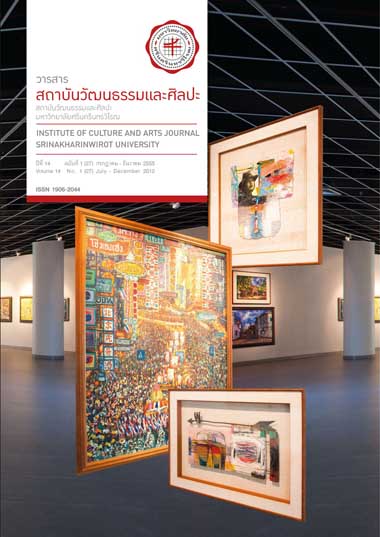กลวิธีการแปลคำนามประสมจากภาษาอังกฤษเป็นภาษาไทย THE TRANSLATION OF COMPOUND NOUNS IN ENGLISH TO THAI
บทคัดย่อ
บทคัดย่อ
งานวิจัยนี้มุ่งศึกษากลวิธีการสื่อสารคำนามประสมข้ามภาษาผ่านการแปลจากภาษาอังกฤษเป็นภาษาไทย โดยรวบรวมข้อมูลที่เป็นคำนามประสมและคู่แปลที่ปรากฏในนวนิยายภาษาอังกฤษเรื่อง “Harry Potter and the Philosopher’s Stone” แต่งโดย J.K. Rowling และในฉบับแปลภาษาไทย แปลโดย สุมาลี บำรุงสุข จำนวน 1,427 คำ ผลการศึกษาพบว่า ผู้แปลใช้กลวิธีการแปลคำนามประสมจากภาษาอังกฤษเป็นภาษาไทยจำนวน 21 กลวิธี โดยเรียงลำดับตามค่าความถี่จากมากไปน้อย ดังนี้ 1) การแปลโดยการแทนที่ด้วยวลีหรือประโยคที่ปรากฏในวัฒนธรรมของภาษาแปล 2) การแปลโดยการสร้างคำประสมใหม่ในภาษาไทยโดยแปลคำในภาษาต้นฉบับแบบตรงตัว 3) การแปลโดยการใช้คำซึ่งเป็นที่รู้จักกันดีในภาษาไทย 4) การแปลโดยการใช้คำทับศัพท์ปนคำไทย 5) การแปลโดยการสร้างคำประสมใหม่ในภาษาไทยโดยแปลคำในภาษาต้นฉบับแบบตรงตัวและใช้คำอื่นที่มีความหมายใกล้เคียงกัน 6) การแปลโดยการแทนที่ด้วยวลีหรือประโยคที่ปรากฏในวัฒนธรรมของภาษาแปล ซึ่งยังคงคำทับศัพท์ไว้ 7) การแปลโดยการแทนที่ด้วยวลีหรือประโยคที่ปรากฏในวัฒนธรรมของภาษาแปล ซึ่งยังคงคำทับศัพท์ไว้ แล้วเพิ่มเติมคำอธิบาย 8) การแปลโดยการสร้างคำประสมใหม่ในภาษาไทยโดยแปลคำในภาษาต้นฉบับแบบตรงตัว แล้วเพิ่มเติมคำอธิบาย 9) การแปลโดยการใช้คำทับศัพท์ปนคำไทย แล้วเพิ่มเติมคำอธิบาย 10) การแปลเพียงคำเดียวโดยแปลคำในภาษาต้นฉบับแบบตรงตัว 11) การแปลโดยการทับศัพท์ หรือการยืมศัพท์ 12) การแปลโดยการทับศัพท์ หรือการยืมศัพท์ แล้วเพิ่มเติมคำอธิบาย 13) การแปลโดยการใช้ข้อความอธิบาย 14) การแปลแบบสื่อความตามบริบท 15) การแปลโดยการละคำ (ไม่แปล) 16) การแปลโดยการใช้คำในภาษาแปลสร้างคำประสมใหม่ พบว่ามีค่าการใช้เท่ากับ 17) การแปลเพียงคำเดียวโดยใช้การทับศัพท์ 18) การแปลโดยการสร้างคำประสมใหม่ในภาษาไทยโดยแปลคำในภาษาต้นฉบับแบบตรงตัวและใช้คำอื่นที่มีความหมายใกล้เคียงกัน แล้วเพิ่มเติมคำอธิบาย พบว่ามีค่าการใช้เท่ากับ 19) การแปลโดยการแทนที่ด้วยสำนวนที่ปรากฏในวัฒนธรรมของภาษาแปล 20) การแปลโดยการสร้างคำประสมใหม่ในภาษาไทยโดยใช้การทับศัพท์เพียงคำเดียว แล้วเพิ่มเติมคำอธิบาย และ 21) การแปลโดยใช้การทับศัพท์ ควบคู่กับการใช้คำซึ่งเป็นที่รู้จักกันดีในภาษาไทย
คำสำคัญ: การสื่อสาร กลวิธีการสื่อสารข้ามภาษา กลวิธีการแปล คำนามประสม
Abstract
This research aims to study cross-language communication strategies of compound nouns through the translation of English to Thai. To achieve this, 1,427 compound nouns appeared at a pair (English-Thai) of the novel “Harry Potter and the Philosopher’s Stone”, English novel was written by J.K. Rowling and Thai novel was translated by Sumali Bamrungsook, are collected. The result of the study demonstrated that there are 21 translation strategies in the order of mean from high to low as follow: 1) Translation by replacing with phrases or sentences of the target-language culture 2) Translation by building a new compound word of the target language which literally translated each lexical item of the source language 3) Translation by using substitutes of the target-language culture 4) Translation by using loan blends (loan and target-language words) 5) Translation by building a new compound word of the target language which literally translated each lexical item of the source language and using other related words 6) Translation by replacing with phrases or sentences of the target-language culture which still kept transliterated words 7) Translation by replacing with phrases or sentences of the target-language culture which still kept transliterated words and adding explanation 8) Translation by building a new compound word of the target language which literally translated each lexical item of the source language and adding explanation 9) Translation by using loan blends (loan and target-language words) and adding explanation 10) Translation by literally translated only one lexical item of the source language 11) Translation by using transliteration 12) Translation by using transliteration and adding explanation 13) Translation by using descriptive statements 14) Translation by using contextual meanings 15) Translation by using omission 16) Translation by building a new compound word with lexical items of the target language; which was equally used to 17) Translation by translated only one lexical item which used transliteration 18) Translation by building new compound word of the target language which literally translated each lexical item of the source language, using other related words and adding explanation; which was equally used to 19) Translation by replacing with idioms of the target-language culture 20) Translation by building new compound word of the target language which used transliteration in only one lexical item and adding explanation and 21) Translation by using transliteration and concurrently using substitutes of the target-language culture.
Keywords: communication, cross-lingual communication strategies, translation strategies, compound nouns
Downloads
ดาวน์โหลด
รูปแบบการอ้างอิง
ฉบับ
ประเภทบทความ
สัญญาอนุญาต
บทความทุกบทความที่ได้รับการตีพิมพ์ถือเป็นลิขสิทธิ์ของวารสารสถาบันวัฒนธรรมและศิลปะ มหาวิทยาลัยศรีนครินทรวิโรฒ



